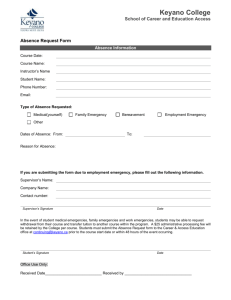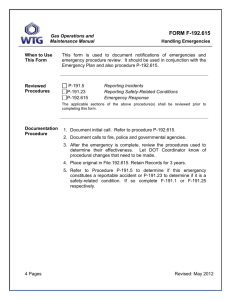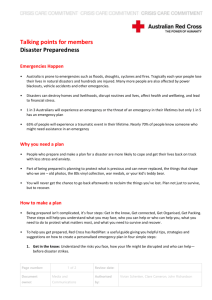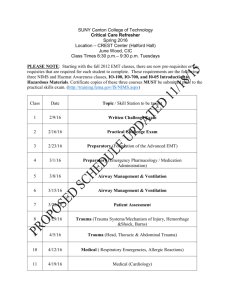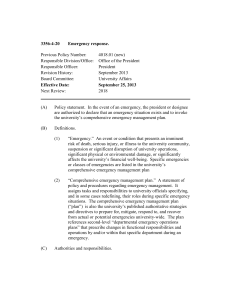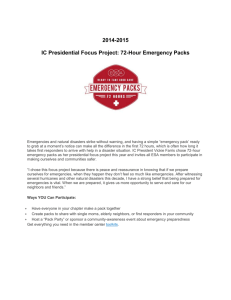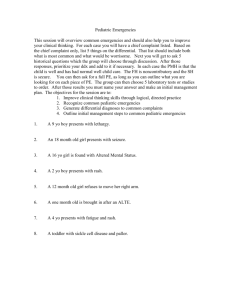May 2014 Instructor's Guide (MS Word format)
advertisement
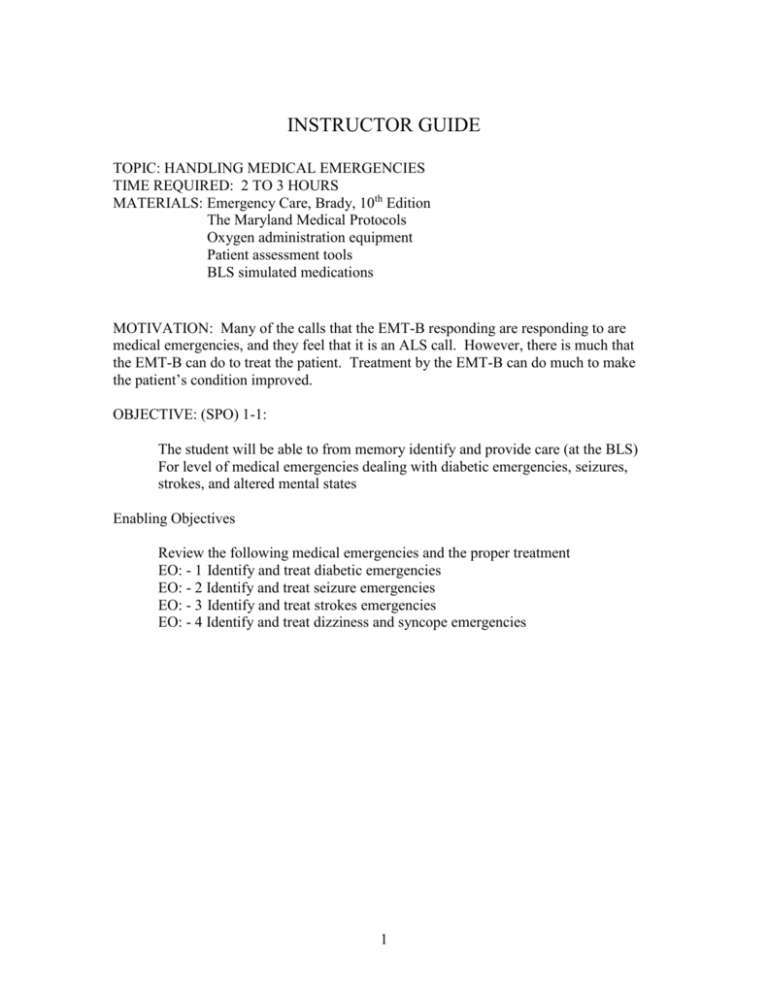
INSTRUCTOR GUIDE TOPIC: HANDLING MEDICAL EMERGENCIES TIME REQUIRED: 2 TO 3 HOURS MATERIALS: Emergency Care, Brady, 10th Edition The Maryland Medical Protocols Oxygen administration equipment Patient assessment tools BLS simulated medications MOTIVATION: Many of the calls that the EMT-B responding are responding to are medical emergencies, and they feel that it is an ALS call. However, there is much that the EMT-B can do to treat the patient. Treatment by the EMT-B can do much to make the patient’s condition improved. OBJECTIVE: (SPO) 1-1: The student will be able to from memory identify and provide care (at the BLS) For level of medical emergencies dealing with diabetic emergencies, seizures, strokes, and altered mental states Enabling Objectives Review the following medical emergencies and the proper treatment EO: - 1 Identify and treat diabetic emergencies EO: - 2 Identify and treat seizure emergencies EO: - 3 Identify and treat strokes emergencies EO: - 4 Identify and treat dizziness and syncope emergencies 1 I. What are diabetic emergencies? A. Causes and types 1. 2. malfunction of the pancreas to produce insulin two types of diabetes, Type 1 and Type 2 a. b. Type 1, commonly called juvenile diabetes, is where the pancreas does not make insulin Type 2, commonly called adult diabetes, is were the pancreas does not function properly do to long term medical problems that the pancreas does not produce enough insulin B. Types of diabetic emergencies 1. Hypoglycemia-low blood sugar levels a. symptoms (1) altered mental status (2) sweaty, clammy skin (3) unconscious (4) fast onset of symptoms b. treatment (1) oral glucose (Maryland Protocols Page 209) (2) 10-15 grams of glucose (3) treat for shock (4) request ALS if not responding (5) administer oxygen 2. Hyperglycemia-high blood sugar levels a. symptoms (1) slow onset of problem (2) increased urination (3) thirsty and hungry (4) acetone odor on breath (5) may act as if intoxicated b. treatment (1) treat for shock (2) request ALS if not in routine (3) administer oxygen (4) give patient glucose (if indicated) 2 II. Seizure Disorders A. B. III. Causes and types 1. the following problems can cause a seizure: a. sudden withdrawal for drugs or alcohol b. brain tumor c. congenital brain defects d. severe infection of the brain e. severe injuries to the head f. some happen from unknown causes 2. types of seizures a. localized to one part of body (etc. arm) b. grand mal seizure (the entire body) c. status epilepticus (one grand mal seizure after another) Treatment of patient 1. patient is still seizing a. place on the floor or ground b. place the patient on side to help drainage from mouth c. remove restrictive clothing d. move items that may injury the patient e. do not restrain the patient while he/she is seizing 2. patient has stopped seizing a. protect their airway b. treat any injuries cause by the seizure c. request ALS if not in route d. transport to hospital Strokes-CVA (cerebral vascular accident) A. Causes and types 1. 2. 3. caused by an artery in the brain ruptures or is blocked can be also caused by trauma to the brain from an injury types of strokes a. Transient ischemic attack- maybe a temporary condition, and the patient reverts back to a normal condition b. hemorrhagic stoke-bleeding into the brain c. ischemic stroke-blockage on an artery in the brain 3 B. Signs and symptoms of strokes 1. 2. 3. 4. 5. 6. 7. 8. C. Treatment and care 1. 2. 3. 4. 5. 6. 7. IV. weakness on 1 side of body slurred speech facial drooping headache un-equal pupils high blood pressure loss of bladder control seizures make patient comfortable take vital signs put patient on high concentration of oxygen 15 liters NRM request ALS if not in route quick transport to medical facilities is very important if you can have at facility closer then ALS can arrive, do not delay transport conscious patient transport in semi-sitting position unconscious patients should be transported on the effected side Dizziness and Syncope (Fainting) A. Causes 1. 2. 3. 4. 5. hypovelemia-low blood volume to the brain bleeding both internal and external Metabolic causes environmental/toxicological causes a. temperature changes b. panic attacks causing hyperventilation c. exposures to chemicals or poisons cardiovascular problems a. slowing of heart rate b. problems in heart’s electrical system c. stroke 4 B. Treatment 1. 2. 3. 4. 5. 6. V. administer high concentration of oxygen loosen any tight clothing put patient flat and elevate the legs, unless this would cause further injury call ALS for further evaluation treat any associated injuries if they fell transport in comfortable position Review Review the Four Medical Emergencies Covered: Diabetic Emergencies Seizers Strokes Dizziness and Syncope REMOTIVATION: Although these types of medical emergencies seen on a regular basis, they can turn into a major incident quickly. Early recognition and treatment can prevent it from happening. Evaluation: Break the class into small groups and have one student play the victim. Give the victim a problem to have, and have a team of students evaluate and treat the problem. 5
